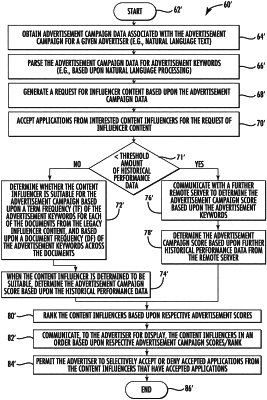| CPC G06Q 30/0242 (2013.01) [G06Q 30/0243 (2013.01); G06Q 30/0244 (2013.01); G06Q 30/0251 (2013.01)] | 20 Claims |

|
1. A content influencer scoring system comprising:
a plurality of influencer computers each associated with a respective content influencer and configured to receive respective influencer content associated with a given product for purchase, each content influencer having influencer historical performance data and legacy influencer content associated therewith; and
a remote server coupled to each of the plurality of influencer computers and configured to
obtain advertisement campaign data associated with an advertisement campaign for a given advertiser,
parse the advertisement campaign data for a plurality of advertisement keywords, and
match content influencers to the advertisement campaign data based on the plurality of advertisement keywords, and for each content influencer, generate an advertisement campaign score by at least
determining whether an amount of influencer historical performance data for the content influencer exceeds a threshold, and when so
determining whether the content influencer is suitable for the advertisement campaign based upon a product of a term frequency (TF) of the advertisement keywords for each of a plurality of documents from the legacy influencer content, and a document frequency (DF) of the advertisement keywords across the plurality of documents, and
when the content influencer is determined to be suitable, determining the advertisement campaign score based upon a logistic regression using the historical performance data so that the advertisement campaign score represents a probability the content influencer is top ranked for the advertisement campaign relative to other content influencers and so that the remote server processes the historical performance data with increased processing speed, and
when the amount of influencer historical performance data for the content influencer does not exceed the threshold
communicate the plurality of advertisement keywords to a further remote server,
obtain further historical performance data from the remote server, the further historical performance data comprising social reach and page view data, and
generate the advertisement campaign score based upon the social reach and page view data.
|